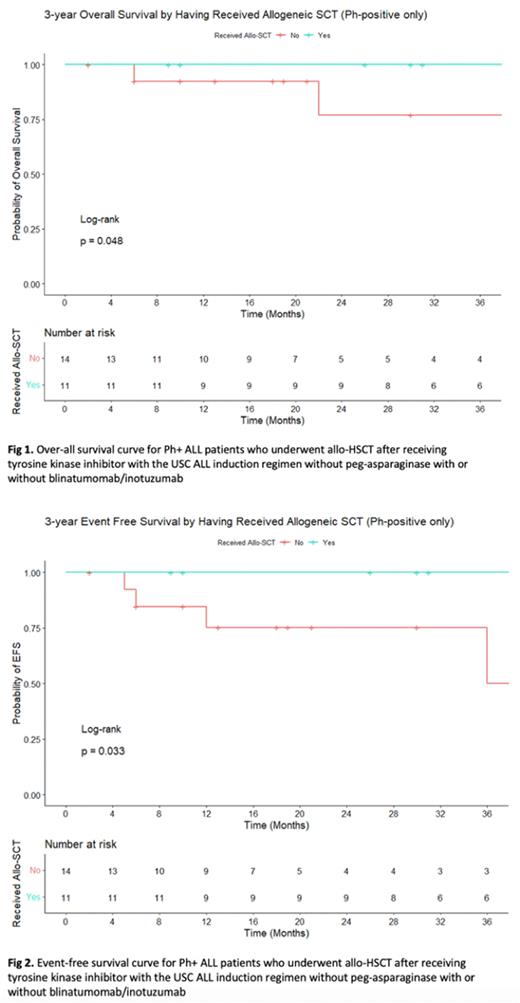Abstract
Introduction:
Prior to the introduction of tyrosine kinase inhibitors (TKIs), the presence of BCR-ABL1 conferred a poor prognosis in patients with acute lymphoblastic leukemia (ALL). We published our analysis in 2017 comparing the survival of Ph-Positive (Ph+) and Ph-negative ALL patients during the period when TKIs were universally available in the United States for Ph+ ALL using a Surveillance, Epidemiology, and End Results (SEER) Database analysis, but despite using TKIs, we have continued to remain reliant on cytotoxic chemotherapy and allogenic hematopoietic stem cell transplant (allo-HSCT) to achieve the best long-term outcomes.
However, with the introduction of more potent TKIs and other novel agents, and better methods for monitoring minimal residual disease (MRD), the best approach is yet to be determined.
In this study we present updated data from our institution with incorporation of TKIs in our modified USC ALL pediatric-based regimen without PEG.
Methods
This retrospective, single institution chart review included adults aged 18 with newly diagnosed Ph+ ALL between 2016 and 2020. Primary objectives were Overall survival (OS) and event-free survival (EFS) at 3 years and secondary objectives were rates of complete remission/complete remission with incomplete recovery (CR/CRi), minimal residual disease (MRD) by flow cytometry and presence of BCR-ABL1 fusion transcript by real time polymerase chain reaction.
Descriptive statistics of patients were reported and evaluated using Fisher's exact test. OS and EFS were reported through Kaplan Meier curves and Log-rank tests. Two-sided p value ≤0.05 considered significant.
RESULTS:
25 Ph+ ALL patients were reviewed. Median age at diagnosis was 43.5 years with 44% males and 56% females in this study. Median BMI was 31.9 kg/ m2. Most patients were Hispanic at 84%, 12% White and 4% Asian.43.5% had hepatic steatosis and 4% had CNS disease pre-induction.
After induction 1, 80% of patients achieved CR/CRi, 4% were refractory, and 50% were MRD negative by flow, with 24% of patients with undetectable BCR-ABL1 by PCR. After induction 2, 90.5% had achieved CR/CRi, none were refractory and 56.3% were MRD negative by flow with 32% of patients with undetectable BCR-ABL1 PCR.
48% of patients received blinatumomab for MRD flow positivity with a median of 3 cycles, none received inotuzumab. 44.4% underwent allo-HSCT, none were sent for CAR-T.
Of note, 64% of patients received Dasatinib only, 0.04% received imatinib and 32% received at least 2 TKIs.
Overall, 12% had known relapse, none were refractory, and 12.5% died. The 3y OS was 89.4%, 3y EFS and DFS was at 77%. When stratified by blinatumomab use, 3y OS was 87.5% vs 91.7% (p=0.49), 3y DFS was 80.2% vs 76.4% and 3y EFS was 80.2% vs 76.4% (p=0.8).
When survival was stratified by transplant status, 3y OS with allo-HSCT was 100% vs 76.9% (p=0.048), 3y EFS/DFS with allo-HSCT was 100% vs 50.1% (p=0.033) (Fig 1-2).
CONCLUSIONS:
The use of the modified USC ALL regimen without PEG for the treatment of newly diagnosed Ph+ ALL combined with TKI continued to lead to a high 3-year OS at 89.4% and 3-year EFS and DFS at 77%.
All patients received TKI, half of the patients received blinatumomab and received allo-HSCT which led to high OS, EFS and DFS even without PEG. This was statistically significant in those who were able to undergo allo-HSCT (3y OS/EFS/DFS 100% vs 76.9% OS/50.1% EFS/DFS) (p=0.033-0.048). This study further highlights the importance of allo-HSCT in Ph+ ALL patients who received TKI without PEG.
Disclosures
Chaudhary:TCR2: Current equity holder in publicly-traded company; Celldex: Current equity holder in publicly-traded company; Moderna: Current equity holder in publicly-traded company; Angeles Therapeutics: Consultancy, Current equity holder in private company; Pancella: Consultancy; Oncotartis: Consultancy; Athelas: Consultancy; Allogene: Current equity holder in publicly-traded company. Douer:Amgen: Speakers Bureau; Servier: Consultancy, Speakers Bureau; Adaptive Biotechnologies: Speakers Bureau. Yaghmour:USC: Current Employment.
Author notes
Asterisk with author names denotes non-ASH members.


